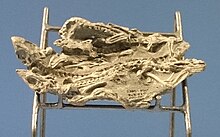Youngina
| Youngina | ||||||||||||
|---|---|---|---|---|---|---|---|---|---|---|---|---|

Skull in side view |
||||||||||||
| Temporal occurrence | ||||||||||||
| Upper Permian ( Wuchiapingium ) | ||||||||||||
| 259.9 to 254.2 million years | ||||||||||||
| Locations | ||||||||||||
|
||||||||||||
| Systematics | ||||||||||||
|
||||||||||||
| Scientific name | ||||||||||||
| Youngina | ||||||||||||
| Broom , 1914 | ||||||||||||
Youngina ( Syn. : Acanthotoposaurus ) is a genus original diapsider reptiles that in wuchiapingian ( Permian lived) about 259.9 to 254.2 million years ago. Fossils have been found in South Africa . The only species described is Youngina capensis . Youngina was discovered by John Young (after the new spelling Yang) and named after him.
features
The skull of Youngina is best known, the postcranial skeleton is not well preserved. The skull is about 5 cm long, oblong and pointed, with large cranial windows at the back of the head and relatively large eye sockets, as well as pointed, conical teeth. The skull is similar to that of the Petrolacosaurus from the Araeoscelidia group , but has larger skull windows with thicker edges and a parietal bone (os parietale), the lateral edges of which extend towards the abdomen and may have served as a starting point for part of the jaw muscles. As with Petrolacosaurus , the square is not indented at the back. The stapes was massive and sloped to the surface of the skull.
The neck was short. The limbs were long, the hand and foot skeleton is original, a sternum and short vertebral processes are reminiscent of the conditions in the Lepidosauromorpha (lizards, snakes and bridge lizards ). Youngina was lizard-like and likely an agile, terrestrial insect eater. The length of the entire animal is estimated to be 35 to 40 cm.
literature
- Michael J. Benton : Paleontology of the vertebrates. Translation of the 3rd English edition by Hans-Ulrich Pfretzschner. Pfeil, Munich 2007, ISBN 978-3-89937-072-0 .
- Robert L. Carroll : Paleontology and Evolution of the Vertebrates. Thieme, Stuttgart 1993, ISBN 3-13774-401-6 .
Web links
- The Paleobiology Database: Youngina
